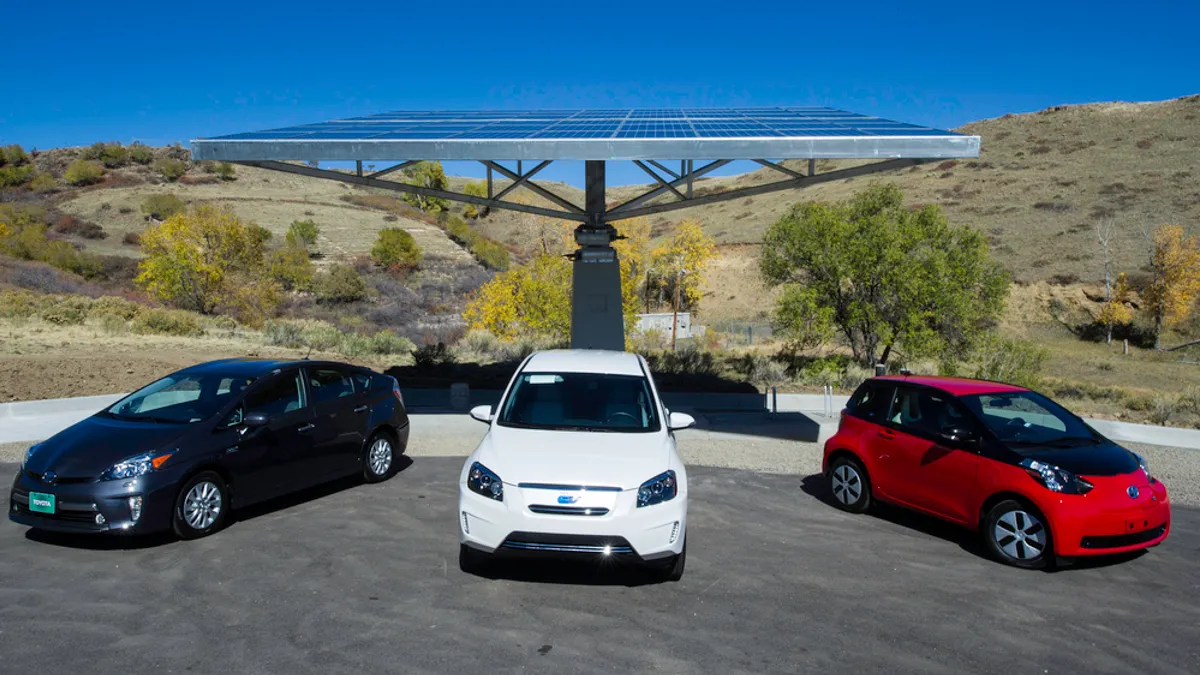Dive Brief:
- Hawaiian Electric Cos. last week laid out its broad long-term vision for electric vehicles on the islands, predicting most cars in its service territories will be electric by 2045.
- The utility company filed its "Electrification of Transportation Strategic Roadmap" with the state's Public Utilities Commission, outlining how it will utilize growing EV adoption to lower system costs, bring more rooftop solar onto the grid and ultimately help meet the state's 100% renewables goal.
- Hawaii trails only California in electric vehicle adoption, and expects the island's electrification of the transportation sector to result in a majority of light duty vehicles being powered by solar, wind, biofuels, geothermal and other renewable resources.
Dive Insight:
Electric vehicle adoption will drive higher demand in Hawaii and across the United States, but utility officials say the trend may be key to reaching the state's all-green energy goals.
Hawaii has at times struggled to bring rooftop solar onto its system, as customer enthusiasm for panels outstripped the grid's capabilities. But in the plan filed Thursday with the PUC, HECO officials say charging cars, trucks, buses and heavy equipment will help to integrate nearly 200,000 new private rooftop solar systems, along with grid-scale renewable projects.
The utility in a statement said its plan "foresees Hawaii in 2045 with most personal light duty vehicles" powered by renewable energy. And in route to that tipping point, officials say the transition can help bring lower costs to all customers of Hawaiian Electric, Maui Electric and Hawaii Electric Light.
Brennon Morioka, Hawaiian Electric's general manager of electrification of transportation, said the roadmap lays out the steps to meet customer needs while "adapting to the new technologies we know are coming."
The utility foresees $60 million in benefits to Hawaiian Electric customers over the next 27 years, including avoided gasoline and vehicle maintenance costs. On Oahu, the transition could benefit the broader economy by more than $200 million. And those benefits could rise significantly if the utility can convince drivers to charge during the day when solar is abundant.
There are already almost 7,000 electric vehicles in Hawaii, and adoption could be extended to busses, railways and other industries.
The report lays out several near-term steps HECO will take:
- The utility plans to work with automakers, dealerships and EV advocates to lower vehicle prices and educate consumers.
- HECO will partner with third-party providers to build out the state's charging network, with a particular focus on charging at workplaces and multi-unit residences.
- HECO also wants to expand the network of utility-owned fast-chargers and public Level 2 chargers.
- The plan also calls for creation of "grid service opportunities" which include demand response incentives to shift vehicle charging to times when solar is abundant.
- HECO will also continue grid modernization efforts to smooth the rise in vehicles on its system and maximize use of renewable energy.
In total, HECO said its plan could create $550 in benefits per electric vehicle to every utility customer over the next 27 years — and up to three times that benefit if charging is managed. Managed charging has become a key concept when discussing EV adoption in order to avoid exacerbating peak demand and utilize renewable energy.
Last year, HECO announced it would shift to time-of-use rates at the DC Fast Charging stations it operates, aiming to adjust customer use of the stations to encourage shorter use times and greater access. Over the next three years, HECO says it will develop "more advanced rates" in response to growth. For residential customers, the PUC recently approved a suite of solar and demand response programs, and the utility is exploring time-of-use, location-based and dynamic pricing.
For commercial fleets, the utility says it will investigate bulk discounts for off-peak purchase of electricity at public chargers and depots.















